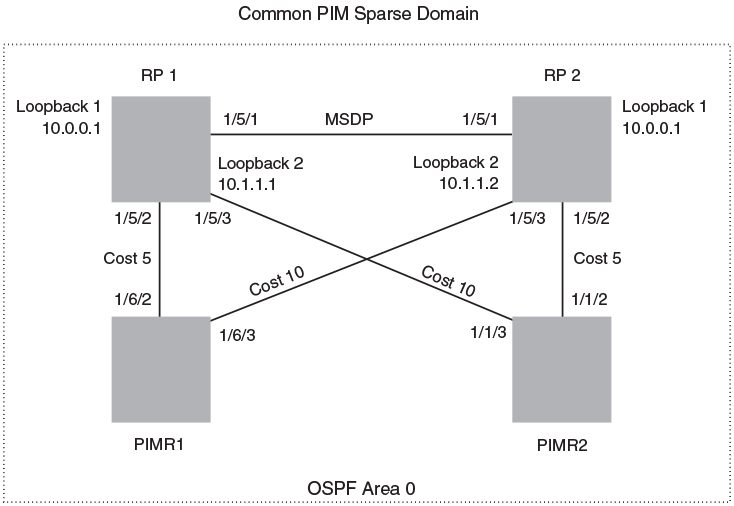Example
The example shown in Figure 9 is a simple MSDP Anycast-enabled network with two RPs and two PIM-SM routers. Loopback 1 in RP 1 and RP 2 have the same IP address. Loopback 2 in RP1 and Loopback 2 in RP2 have different IP addresses and are configured as MSDP peering IP addresses in a mesh configuration.
In the PIM configuration for PIM-SM routers PIMR1 and PIMR2 the RP address is configured to be the anycast RP address that was configured on the Loopback 1 interfaces on RP1 and RP2. OSPF is configured as the IGP for the network and all of the devices are in OSPF area 0.
Since PIMR1 has a lower cost path to RP1 and PIMR2 has a lower cost path to RP2 they will register with the respective RPs when both are up and running. This shares the load between the two RPs. If one of the RPs fails, the higher-cost path to the IP address of Loopback 1 on the RPs is used to route to the still-active RP.
The configuration examples demonstrate the commands required to enable this application.

RP 1 configuration
The following commands provide the configuration for the RP 1 router in Figure 9.
RP1(config)#router ospf RP1(config-ospf-router)# area 0 RP1(config-ospf-router)# exit RP1(config)# interface loopback 1 RP1(config-lbif-1)# ip ospf area 0 RP1(config-lbif-1)# ip ospf passive RP1(config-lbif-1)# ip address 10.0.0.1/32 RP1(config-lbif-1)# ip pim-sparse RP1(config-lbif-1)# exit RP1(config)# interface loopback 2 RP1(config-lbif-2)# ip ospf area 0 RP1(config-lbif-2)# ip ospf passive RP1(config-lbif-2)# ip address 10.1.1.1/32 RP1(config-lbif-2)# exit RP1(config)# interface ethernet 1/5/1 RP1(config-if-e1000-1/5/1)# ip ospf area 0 RP1(config-if-e1000-1/5/1)# ip address 192.1.1.1/24 RP1(config-if-e1000-1/5/1)# ip pim-sparse RP1(config)# interface ethernet 1/5/2 RP1(config-if-e1000-1/5/2)# ip ospf area 0 RP1(config-if-e1000-1/5/2)# ip ospf cost 5 RP1(config-if-e1000-1/5/2)# ip address 192.2.1.1/24 RP1(config-if-e1000-1/5/2)# ip pim-sparse RP1(config)# interface ethernet 1/5/3 RP1(config-if-e1000-1/5/3)# ip ospf area 0 RP1(config-if-e1000-1/5/3)# ip ospf cost 10 RP1(config-if-e1000-1/5/3)# ip address 192.3.1.1/24 RP1(config-if-e1000-1/5/3)# ip pim-sparse RP1(config-if-e1000-1/5/3)# exit RP1(config)# router pim RP1(config-pim-router)# rp-candidate loopback 1 RP1(config-pim-router)# exit RP1(config)# router msdp RP1(config-msdp-router)# msdp-peer 10.1.1.2 connect-source loopback 2 RP1(config-msdp-router)# originator-id loopback 2
RP 2 configuration
The following commands provide the configuration for the RP 2 router in Figure 9.
RP2(config)#router ospf RP2(config-ospf-router)# area 0 RP2(config-ospf-router)# exit RP2(config)# interface loopback 1 RP2(config-lbif-1)# ip ospf area 0 RP2(config-lbif-1)# ip ospf passive RP2(config-lbif-1)# ip address 10.0.0.1/32 RP2(config-lbif-1)# ip pim-sparse RP2(config-lbif-1)# exit RP2(config)# interface loopback 2 RP2(config-lbif-2)# ip ospf area 0 RP2(config-lbif-2)# ip ospf passive RP2(config-lbif-2)# ip address 10.1.1.2/32 RP2(config-lbif-2)# exit RP2(config)# interface ethernet 1/5/1 RP2(config-if-e1000-1/5/1)# ip ospf area 0 RP2(config-if-e1000-1/5/1)# ip address 192.1.1.2/24 RP2(config-if-e1000-1/5/1)# ip pim-sparse RP2(config)# interface ethernet 1/5/2 RP2(config-if-e1000-1/5/2)# ip ospf area 0 RP2(config-if-e1000-1/5/2)# ip ospf cost 5 RP2(config-if-e1000-1/5/2)# ip address 192.5.2.1/24 RP2(config-if-e1000-1/5/2)# ip pim-sparse RP2(config)# interface ethernet 1/5/3 RP2(config-if-e1000-1/5/3)# ip ospf area 0 RP2(config-if-e1000-1/5/3)# ip ospf cost 10 RP2(config-if-e1000-1/5/3)# ip address 192.6.1.2/24 RP2(config-if-e1000-1/5/3)# ip pim-sparse RP2(config-if-e1000-1/5/3)# exit RP2(config)# router pim RP2(config-pim-router)# rp-candidate loopback 1 RP2(config-pim-router)# exit RP2(config)# router msdp RP2(config-msdp-router)# msdp-peer 10.1.1.1 connect-source loopback 2 RP2(config-msdp-router)# originator-id loopback 2
PIMR1 configuration
The following commands provide the configuration for the PIMR1 router in Figure 9.
PIMR1(config)#router ospf PIMR1(config-ospf-router)# area 0 PIMR1(config-ospf-router)# exit PIMR1(config)# interface ethernet 1/6/2 PIMR1(config-if-e1000-1/6/2)# ip ospf area 0 PIMR1(config-if-e1000-1/6/2)# ip ospf cost 5 PIMR1(config-if-e1000-1/6/2)# ip address 192.2.1.2/24 PIMR1(config-if-e1000-1/6/2)# ip pim-sparse PIMR1(config)# interface ethernet 1/6/3 PIMR1(config-if-e1000-1/6/3)# ip ospf area 0 PIMR1(config-if-e1000-1/6/3)# ip ospf cost 10 PIMR1(config-if-e1000-1/6/3)# ip address 192.6.1.1/24 PIMR1(config-if-e1000-1/6/3)# ip pim-sparse PIMR1(config-if-e1000-1/6/3)# exit PIMR1(config)# router pim PIMR1(config-pim-router)# rp-address 10.0.0.1 PIMR1(config-pim-router)# exit
PIMR2 configuration
The following commands provide the configuration for the PIMR2 router in Figure 9.
PIMR2(config)#router ospf PIMR2(config-ospf-router)# area 0 PIMR2(config-ospf-router)# exit PIMR2(config)# interface ethernet 1/1/2 PIMR2(config-if-e1000-1/1/2)# ip ospf area 0 PIMR2(config-if-e1000-1/1/2)# ip ospf cost 5 PIMR2(config-if-e1000-1/1/2)# ip address 192.5.2.2/24 PIMR2(config-if-e1000-1/1/2)# ip pim-sparse PIMR2(config)# interface ethernet 1/1/3 PIMR2(config-if-e1000-1/1/3)# ip ospf area 0 PIMR2(config-if-e1000-1/1/3)# ip ospf cost 10 PIMR2(config-if-e1000-1/1/3)# ip address 192.3.1.2/24 PIMR2(config-if-e1000-1/1/3)# ip pim-sparse PIMR2(config-if-e1000-1/1/3)# exit PIMR2(config)# router pim PIMR2(config-pim-router)# rp-address 10.0.0.1 PIMR2(config-pim-router)# exit
